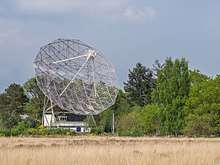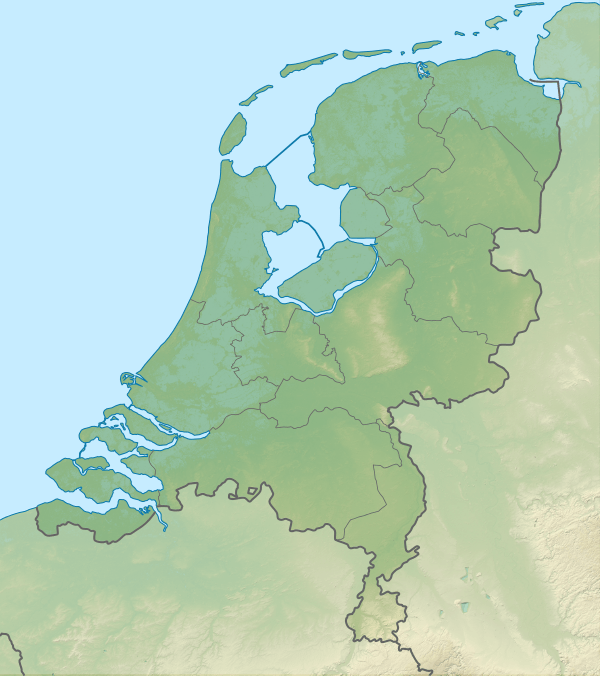Dwingeloo Radio Observatory
 The 25 meter Dwingeloo radio telescope in 2014 | |
| Observatory |
Top 100 of Dutch monuments 1940-1958 |
|---|---|
| Location(s) |
Dwingeloo, Westerveld, Netherlands |
| Coordinates |
52°48′43″N 6°23′46″E / 52.8119°N 6.3961°ECoordinates: 52°48′43″N 6°23′46″E / 52.8119°N 6.3961°E |
| Telescope style |
Radio telescope |
| Diameter |
25 m (82 ft 0 in) |
 Location of Dwingeloo Radio Observatory | |
The Dwingeloo Radio Observatory is a single-dish radio telescope near the village of Dwingeloo (Dutch pronunciation: [ˈdʋɪŋəloː]) in the northeastern Netherlands. Construction started in 1954, and the telescope was completed in 1956. The radio telescope has a diameter of 25 m.[1] At the time of completion it was the largest radio telescope in the world, but it was overtaken in 1957 by the 76-m Lovell Telescope.
As of 2000, it was no longer in operation in an official capacity. Since August 2009, the radio telescope has been national heritage site (rijksmonument).[1] The telescope dish was removed for restoration in June 2012.[2] The "C.A. Muller Radio Astronomy Station" foundation ("CAMRAS" for short) restored the telescope to working order. The dish was remounted in November 2012.[3]
Paul Boven (Joint Institute for VLBI in Europe (JIVE), CAMRAS), along with radio amateurs and amateur astronomers, use the telescope for projects, one being Earth–Moon–Earth communication, also known as moonbounce, which allows for people on different parts of Earth to communicate via the Moon. In this technique, radio wave signals are aimed at the Moon by one location, bounce off the Moon's surface, and are detected by an antenna at a different location on Earth.
The radio telescope is owned by ASTRON, the Netherlands Institute for Radio Astronomy. The site of the Dwingeloo Radio Observatory also houses most of the staff of ASTRON and a test site for the Low Frequency Array radio telescope, LOFAR.
Two galaxies are named after this telescope: Dwingeloo 1 and Dwingeloo 2.
References
- 1 2 Monumentnummer: 530829 - radiotelescoop, Rijksdienst voor het Cultureel Erfgoed. Retrieved 20 January 2016.
- ↑ Dish Dwingeloo Telescope temporarily dismantled, ASTRON, 2012.
- ↑ Dish Dwingeloo radio telescope back on tower, ASTRON, 2012.
External links
| Dutch Rijksmonument 530829 |

- Westerhout, Gart (December 1958). "A survey of the continuous radiation from the Galactic System at a frequency of 1390 Mc/s". Bulletin of the Astronomical Institutes of the Netherlands. 14: 215. Bibcode:1958BAN....14..215W.